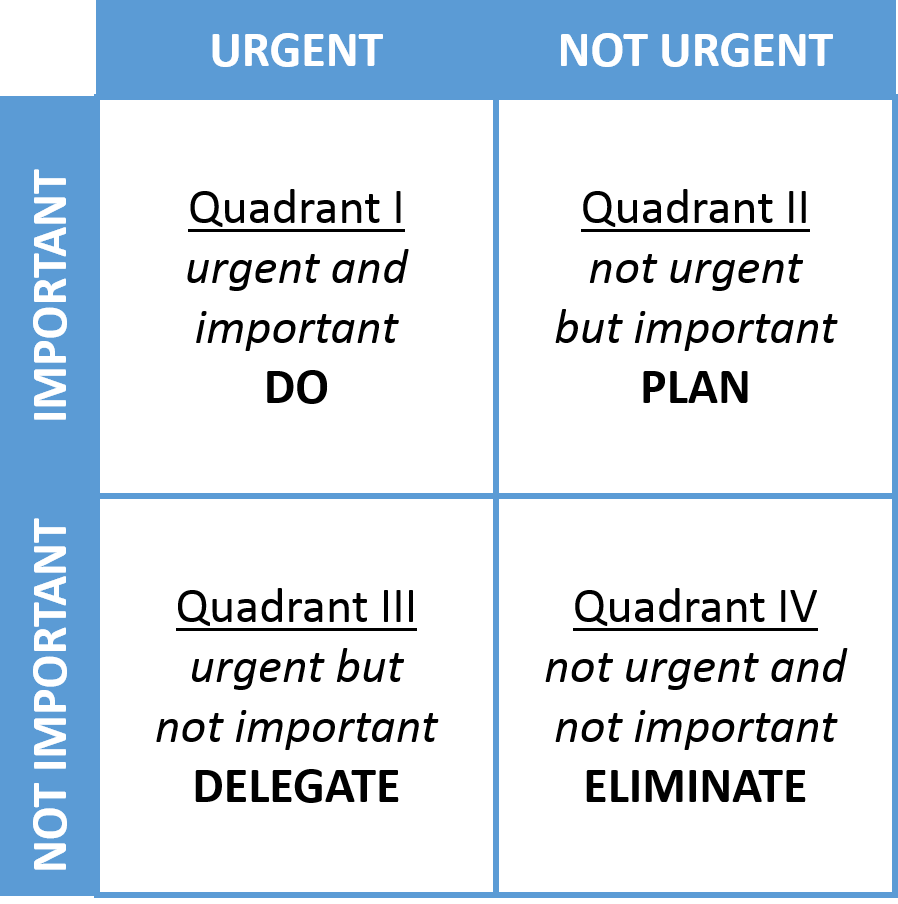The Coronavirus and the Covey Matrix
Why it’s easy to forget what’s not urgent but important
A great tool for many leaders is the Covey Matrix, also known as the Eisenhower Decision Matrix:

It’s a great tool for leaders (and everyone else) to decide what work to focus on, and in so doing, how to allocate your time.
Some quick definitions
Importance is the level of the work’s importance for your organization / company / department.
Urgency is the degree to which the work needs to be done now.
Some examples
Urgent and Important: Dealing with the coronavirus / COVID-19 (It’s important, and you need to deal with it now.)
Not Urgent but Important: Planning for a crisis, e.g. what if our employees can’t get to work? (It’s important, but pre-COVID-19, something many leaders presumed wasn’t likely to happen; so not urgent at that time.)
Urgent but Not Important: Interruptions by well-meaning colleagues. (We’ve all been there. Someone asks if you have 5 minutes, you say “yes”, and a minute in to their speaking, you wonder why you said “yes”. What was urgent for them, was not important for you, and often not important for the organization / company / department.)
Not Urgent and Not Important: Doing Facebook at work. (Enough said.)
Being orchestrated by the urgent
Covey’s research showed that leaders tend to be orchestrated by what’s urgent, not by what’s important.
Why?
Because it’s what’s pressing. It’s what’s top of mind. It’s often the quickest and the easiest thing to do.
If you’ve ever felt the satisfaction of clearing off your to-do list, you know what I’m talking about. But were all those items important? What else could you have done with some of that time?
Covey asserted that, instead, leaders need to focus on what’s important.
The coronavirus / COVID-19
And here’s where the coronavirus / COVID-19 comes into play.
The problem with things that are not urgent but important is that they’re easy to postpone.
“If I don’t do strategic planning today, not a problem. The company will still be here tomorrow.”
“If I don’t plan for business interruptions today, no worries. We’ll still be in business tomorrow.”
“Don’t spend time today developing my leaders to handle a crisis? Not a big issue. We’ll do it some other time.”
It’s making the time, not finding the time
All of these examples take time, and often more time than leaders think they have.
Why? In many cases because their calendar is filled with what’s urgent, not with what’s important.
And so many of the issues that take time to plan for or anticipate are not addressed fully. Until when? You got it. When they become a crisis.
And unfortunately, it’s a bit too late to deal with these thoughtfully and in a timely way once they’ve become a crisis.
Why? Because they needed the investment of considerable time before they became a crisis, i.e. before they become important and urgent.
But here we are
But alas here many leaders find themselves. And this is not meant to be a blame or shame piece.
If you should find yourself behind the curve on dealing with the consequences of the coronavirus / COVID-19, no doubt you will put the time in now that you should have put in a few months previously, just in a more concentrated and 24/7 way.
For those leaders who are in the thick of it now, and for the rest of us too, this can serve as a great reminder, going forward, of the critical value, need, and even work/life balance benefit of staying focused on the important, and not the urgent.
Sign up for The Advisory Alliance 60-Second Read
Categories
- board of directors
- career
- career development
- change
- coaching
- communication
- compensation
- conflict
- consulting
- critical thinking
- culture
- decision-making
- education
- experiential learning
- feedback
- high potential
- hr
- immigration
- influence
- innovation
- jobs
- knowledge economy
- leadership
- leadership development
- leadership style
- learning
- management
- management development
- motivation
- selection
- self-actualization
- skills shortage
- succession planning
- talent development
- talent management
- time management
- uncategorized
